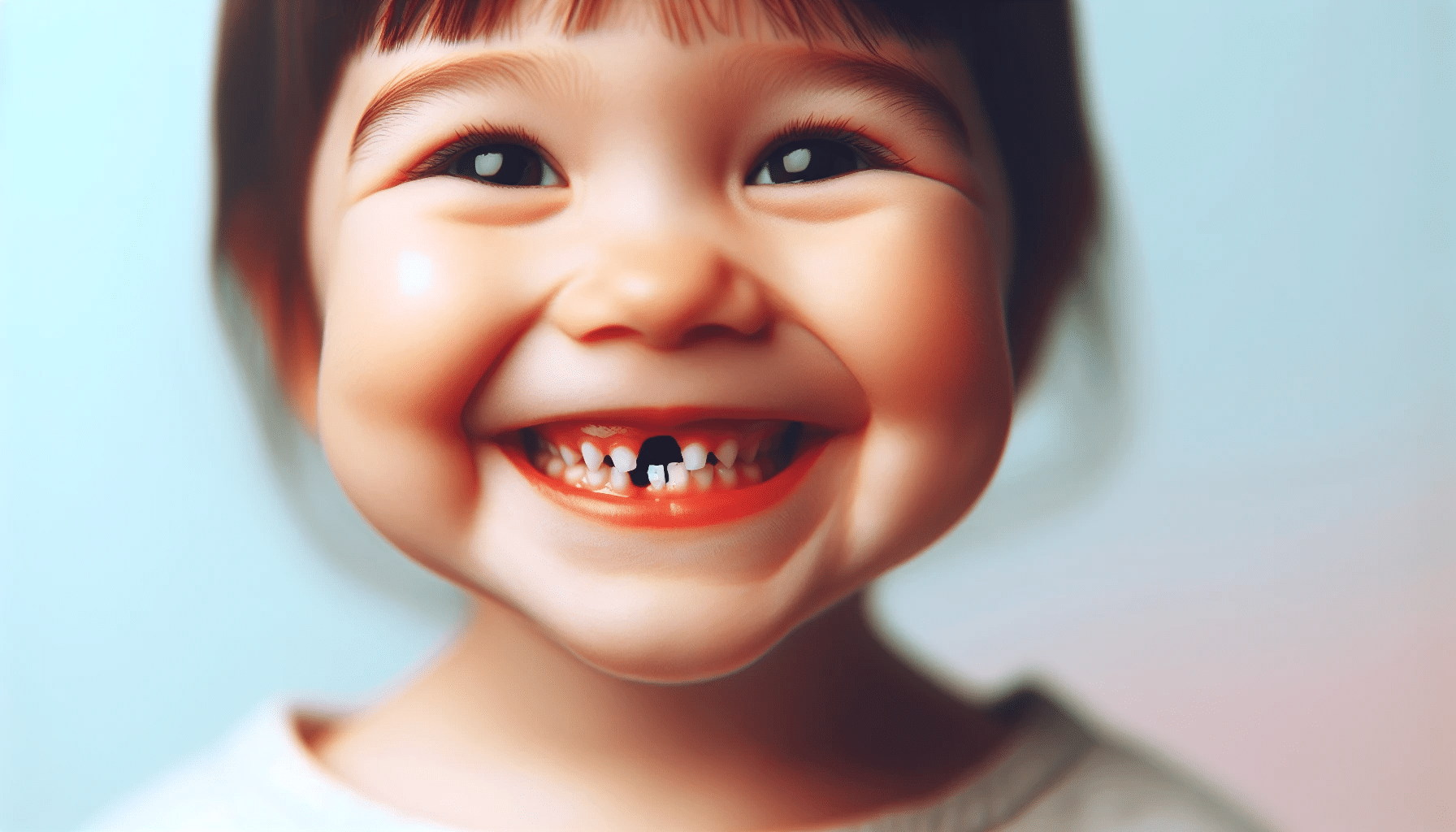When Do Kids Start Losing Teeth: A Parent’s Essential Guide
Remember those nostalgic days when the tooth fairy visited our homes, leaving behind a small token in exchange for our precious baby teeth? As parents, it’s now our turn to guide our children through this rite of passage – losing their baby teeth and welcoming their permanent ones. But when do kids start losing teeth, and how can you ensure a smooth transition? Let’s walk through this toothy adventure together!
Key Takeaways
- The typical timeline of baby teeth loss is between ages 6-12.
- Central incisors, lateral incisors and primary molars usually fall out at different stages during this time frame.
- Routine dental checkups are essential for early detection of potential problems and to ensure good oral health in kids.
The Timeline of Baby Teeth Loss

Children typically start losing baby teeth between ages 6-7, with all 20 baby teeth falling out by age 12. While the tooth fairy may be eagerly waiting, the process of kids start losing teeth can be quite a roller coaster for both kids and parents. We’ll guide you through the sequence and timing of losing teeth.
First Teeth to Go: Central Incisors
The central incisors, the two front teeth at the center of the upper and lower jaw, are usually the first of a child’s baby teeth to bid farewell. They typically fall out between 6 and 7 years of age. The timing of losing teeth can be influenced by factors such as genetics, gum health, and developmental irregularities. For kids, having a loose tooth can be a mixed bag of emotions, ranging from excitement to anxiety, and sometimes accompanied by mild discomfort.
As parents, reassuring your children that losing their central incisors is a normal part of growing up becomes necessary, especially when kids lose teeth. Offer comfort and support, and remind them that as they lose teeth, permanent teeth will soon take their place, laying the foundation for a lifetime of healthy smiles.
Following Suit: Lateral Incisors and Primary Molars
Following the exit of the central incisors, the lateral incisors and primary molars usually fall out between ages 7-11. The lateral incisors, the teeth adjacent to the central incisors, are usually shed between 7 and 8 years of age. The process of losing lateral incisors is similar to that of primary molars, both falling out between ages 7 and 8, adding to the total count of baby teeth a child loses.
This stage offers a good chance to stress the need for good oral hygiene and healthy habits. Encourage your child to brush and floss regularly, visit the dentist, and maintain a balanced diet to ensure the incoming adult teeth have a strong foundation for a lifetime of healthy grins.
The Final Stage: Canines and Second Primary Molars
The grand finale in the baby teeth loss saga occurs between ages 9-12 when canines and second primary molars fall out. The upper set of baby teeth normally exfoliates between the ages of 10 to 12. On the other hand, the lower set usually falls out in the range of 9 to 12 years of age. After the last baby tooth takes its bow, your child should have their full set of 28 permanent adult teeth by age 13. So, how many baby teeth are there in total? The answer is 20, which are replaced by the adult teeth as they fall out.
Parents can aid their child’s comfort after a tooth falls out by offering age-appropriate pain relief like acetaminophen (Tylenol®) or ibuprofen (Advil®) if necessary. Additionally, avoid letting your child use straws in the days following a tooth loss, as suction can disrupt the blood clot necessary for proper healing.
Recognizing Signs of Loose Teeth

As your child experiences tooth loss, recognizing the signs of loose teeth becomes necessary. Common indicators include wiggling, gaps, and shifting of teeth. Pay attention to your child’s oral health and be aware of any discomfort or inflammation that may accompany a loose tooth.
Differentiating between normal and abnormal loose teeth is crucial to ensure your child’s smooth transition. Consider the following factors to make informed decisions about your child’s oral health:
- Your child’s age
- The order of tooth loss
- Pain levels
- Gum health
- Regular dental checkups
Preparing Your Child for Their First Tooth Loss

To ready your child for the moment they lose their first tooth, help them understand the process and provide comfort and support. Reassure your child that losing teeth is a natural part of growing up and help them feel excited about the milestone of maturing and developing.
When a tooth falls out, and the gum starts bleeding, have your child swish their mouth out with water or bite down on a piece of gauze to control the bleeding. If the bleeding continues for more than an hour, contact your child’s dentist for further guidance.
To help manage soreness or discomfort, offer an ice pack or age-appropriate pain relief, and don’t forget to involve the tooth fairy to make the experience more magical.
Caring for Permanent Teeth: Tips and Tricks

As your child’s permanent teeth start to emerge, maintaining good oral hygiene becomes even more crucial. Here are some tips to ensure healthy teeth and gums for a lifetime:
- Proper brushing
- Flossing
- Regular dental checkups
- A balanced diet
We’ll further analyze these fundamental aspects of oral care for your child’s primary teeth, paving the way for healthy permanent teeth.
Brushing and Flossing Techniques
Teach your child the correct brushing technique for optimal oral health. Here are the steps to follow:
- Wet the toothbrush.
- Position it at a 45-degree angle to the gum line.
- Make gentle circular motions.
- Brush all surfaces of the teeth.
- Rinse thoroughly.
Encourage your child to look after their oral health. Make sure they brush for at least two minutes, twice a day.
Apart from brushing, teaching your child the correct flossing techniques is equally important. Here are the steps to follow:
- Have them tear off approximately 18 inches of floss.
- Wind most of it around one fingertip, and hold the floss firmly between their thumbs and forefingers.
- Guide them to gently floss between their teeth, curving the floss around each tooth, and sliding it under the gumline.
- Repeat for all teeth, using a fresh section of floss for each tooth.
Importance of Dental Checkups
Routine dental checkups are key for early detection of possible problems and forming personalized oral care plans. As your child’s permanent teeth come in, dental visits become even more critical to ensure proper growth and alignment. Children should visit the dentist every six months.
Most dental insurance plans for kids generally include 100% coverage for preventive appointments, such as checkups and cleanings. Make the most of these benefits to maintain your child’s oral health and catch any problems before they become more significant concerns.
Diet and Oral Health
A balanced diet significantly contributes to promoting healthy teeth. Encourage your child to consume calcium-rich dairy products, protein-rich foods, vitamin C-rich fruits, leafy greens, and other nutritious options. Limiting sugar intake is also essential, as sugar can lead to cavities and gum disease.
A diet rich in the following foods provides essential nutrients for strong, healthy teeth:
- Dairy products
- Lean meats
- Nuts
- Beans
- Green leafy vegetables
- Fish
- Fruits
- Vegetables
By promoting healthy eating habits, you can help your child lay the foundation for a lifetime of dazzling smiles.
Handling Early or Late Tooth Loss

A pediatric dentist can assist in managing early or late tooth loss. If your child loses a tooth before the age of four, the adult tooth may not emerge in the correct position. Early tooth loss can be indicative of underlying systemic issues such as hypophosphatemia, thyroid dysfunctions, and certain blood disorders.
In cases where baby teeth do not fall out naturally, dentists may extract them to facilitate the growth of permanent teeth into position. Consult with your pediatric dentist to determine the best course of action for your child’s specific situation.
When Adult Teeth Emerge
Adult teeth usually start to appear around age 6, continuing as baby teeth fall out. On average, children will start to experience the emergence of their first permanent molars between the ages of six and seven. These new adult teeth will gradually replace the baby teeth, leading to a full set of 28 permanent adult teeth by age 13.
Third molars, or wisdom teeth, are the last permanent teeth to develop. They usually show up between 17 and 21 years of age. However, not everyone gets wisdom teeth. Keep track of your child’s dental development and maintain regular dental visits to ensure a healthy and beautiful smile.
Today’s Dental: Your Partner in Pediatric Dentistry
At Today’s Dental, a top-rated dental clinic servicing the Omaha NE area, we’re committed to helping your child maintain a healthy smile. Our extensive pediatric dentistry services encompass:
- Regular check-ups
- Cleanings
- Fluoride treatments
- Restorative treatments such as fillings and dental sealants
Our experienced and friendly pediatric dentists are trained to make the dental experience enjoyable and comfortable for children.
Today’s Dental is easily accessible for families across the Omaha area. Schedule an appointment online or by calling the clinic and let us be your partner in maintaining your child’s healthy smile.
Summary
The journey of losing baby teeth and welcoming permanent ones is a significant milestone in a child’s life. As parents, it’s essential to understand the timeline of baby teeth loss, recognize signs of loose teeth, and prepare your child for the process. Caring for permanent teeth through proper oral hygiene, regular dental checkups, and a balanced diet is vital for a lifetime of healthy smiles. Let Today’s Dental be your partner in pediatric dentistry, providing the guidance and care your child needs to maintain a dazzling grin.





